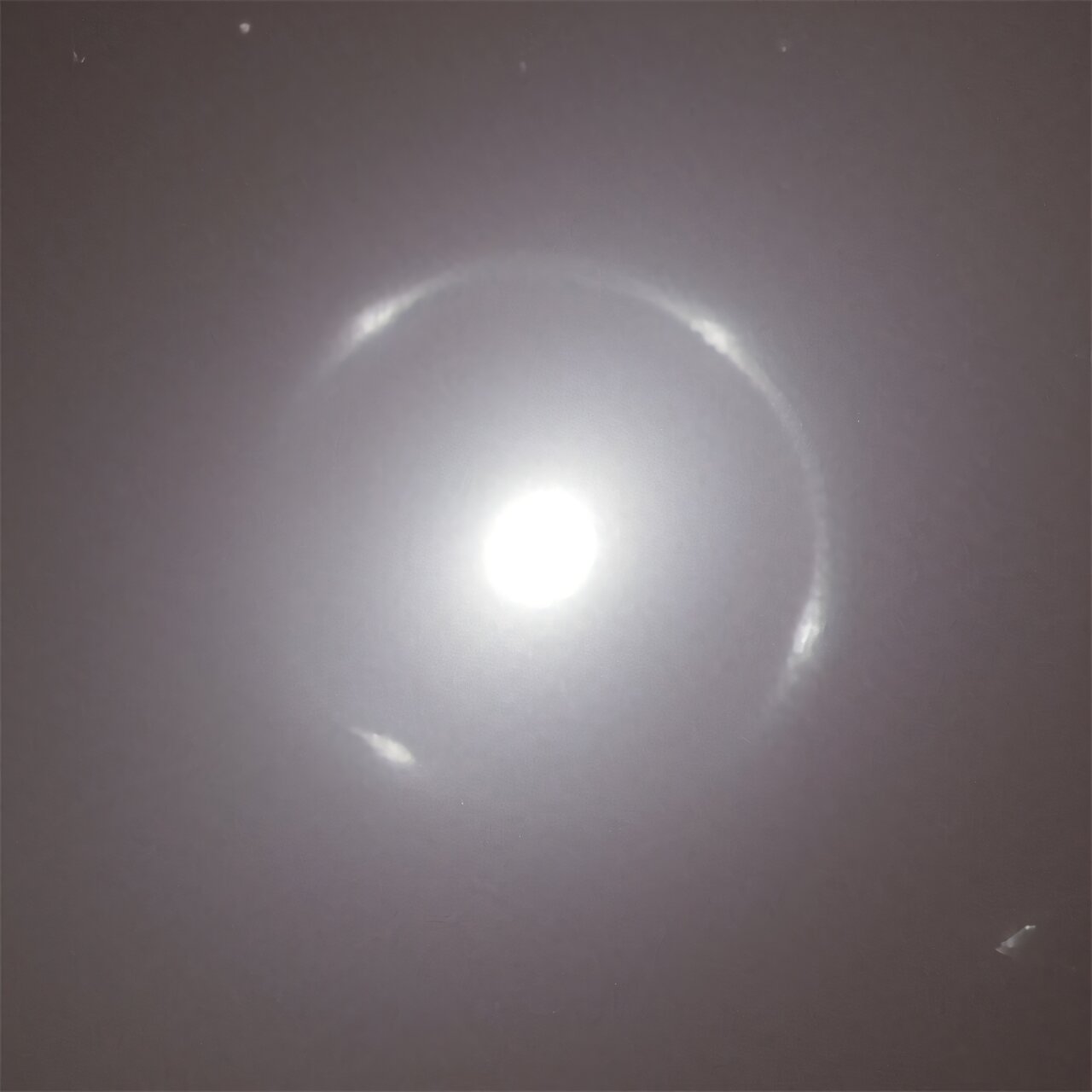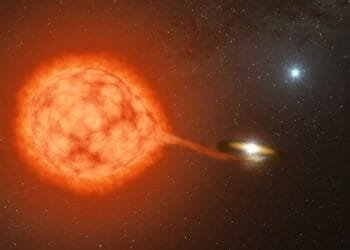On July 1, 2023, the Euclid spacecraft embarked on its ambitious six-year mission to explore the universe’s dark side, focusing on understanding the mysterious phenomena of dark energy and dark matter. Before its main survey could officially begin, however, Euclid had to undergo a critical phase of testing to ensure all systems were functioning as expected. During this period, the spacecraft sent some preliminary images back to Earth in September 2023, but these images were intentionally blurry as part of the calibration process.
In what appeared to be just a routine phase of the mission, Euclid Archive Scientist Bruno Altieri noticed something intriguing in one of the blurry images. Despite the fuzziness, a peculiar phenomenon caught his eye—a potential Einstein ring. Intrigued by this anomaly, Altieri and his team decided to delve deeper into the data, and their persistence paid off.
“I look at the data from Euclid as it comes in,” explained Altieri. “Even from that first observation, I could see it, but after Euclid made more observations of the area, we could see a perfect Einstein ring. For me, with a lifelong interest in gravitational lensing, that was amazing.”
The discovery turned out to be much more significant than initially thought. The Einstein ring, an extremely rare and captivating cosmic phenomenon, had been hiding in plain sight. The ring was located around a galaxy known as NGC 6505, which is approximately 590 million light-years away from Earth—a relatively nearby distance in cosmic terms. This marks the first time that the Einstein ring surrounding the center of NGC 6505 has been detected, thanks to Euclid’s high-resolution instruments.
The findings, which shed light on this extraordinary discovery, were published in the prestigious scientific journal Astronomy and Astrophysics.
What is an Einstein Ring?
An Einstein ring occurs when light from a distant galaxy is bent by the gravity of a foreground galaxy or another massive object, creating a ring-like effect. This phenomenon is a dramatic manifestation of gravitational lensing, a prediction made by Albert Einstein’s general theory of relativity. According to Einstein’s theory, massive objects, such as galaxies, warp the fabric of space-time, bending light in a manner similar to how a magnifying lens bends light rays. The result is that light from a distant source galaxy, which would otherwise be blocked, can bend around the foreground object, creating the appearance of a ring.
In the case of this recent discovery, the light from a background galaxy—located 4.42 billion light-years away—was distorted by the gravity of the closer NGC 6505 galaxy. This far-off galaxy, which has not been observed before and still remains unnamed, is so distant that its light had to travel through a cosmic “lens” to reach us.

The Einstein ring surrounding the galaxy NGC 6505 is considered particularly special for several reasons. It is not only a rare phenomenon but also an incredibly useful one for scientific exploration. Conor O’Riordan, a lead researcher at the Max Planck Institute for Astrophysics, explains:
“All strong lenses are special because they’re so rare, and they’re incredibly useful scientifically. This one is particularly special because it’s so close to Earth, and the alignment makes it very beautiful.”
A Closer Look at NGC 6505 and the Einstein Ring
The foreground galaxy, NGC 6505, had been known to astronomers since its discovery in 1884, but despite its long history, this Einstein ring was never previously observed. This highlights the capabilities of Euclid’s advanced instruments in revealing hidden features, even in well-studied regions of the cosmos.
“What’s particularly intriguing is that this ring was observed within a well-known galaxy,” said Valeria Pettorino, the Euclid Project Scientist at ESA. “The galaxy has been known to astronomers for a very long time. And yet, this ring was never observed before. This discovery demonstrates how powerful Euclid is, finding new things even in places we thought we knew well.”

The Einstein ring is a prime example of strong gravitational lensing, where the distortion caused by the gravitational field of a foreground object is so extreme that it can form a perfect ring around the galaxy. Studying such phenomena provides valuable insights into the expansion of the universe, the nature of dark energy, and the presence of dark matter—both invisible and mysterious substances that make up much of the universe’s mass.
Einstein Rings and Their Role in Modern Astrophysics
The discovery of an Einstein ring is not just a visual marvel; it holds immense scientific significance. Gravitational lensing, particularly strong lensing, allows astronomers to study distant and faint galaxies that would otherwise be invisible. By examining how light is bent and stretched as it passes through massive cosmic structures, scientists can make inferences about the mass distribution of galaxies, the presence of dark matter, and the geometry of space-time itself.
Einstein rings provide a natural laboratory to test general relativity and probe the universe’s structure. Conor O’Riordan notes:
“Strong lenses like this one are extremely valuable because they let us investigate how mass is distributed in galaxies and clusters. We can also learn about the dark matter that surrounds these galaxies, since dark matter exerts gravitational effects but cannot be directly observed. This ring will allow us to probe the nature of dark matter and its role in shaping the universe.”
Furthermore, the alignment that creates the perfect Einstein ring is so rare that its occurrence is akin to finding a cosmic needle in a haystack. Until now, fewer than 1,000 strong gravitational lenses have been identified, and even fewer have been imaged at such high resolution. The fact that Euclid has already found one of these rings so early in its mission underscores the immense potential of the spacecraft to uncover more hidden phenomena across the universe.
Euclid’s Mission and Future Prospects
Although the discovery of this stunning Einstein ring is a remarkable highlight of the Euclid mission, it is not the primary goal of the mission. Euclid’s main objective is to explore the more subtle effects of weak gravitational lensing, where galaxies appear only mildly stretched or displaced due to the gravitational influence of large structures between the background galaxy and Earth.
The primary aim of the mission is to study the large-scale structure of the universe, specifically how dark energy and dark matter affect the expansion of the cosmos. By mapping a significant portion of the universe, Euclid will help astronomers better understand the forces at play in the universe’s evolution.
On February 14, 2024, Euclid began its detailed sky survey, collecting vast amounts of data to create the most extensive 3D map of the universe ever attempted. With this data, scientists will analyze the distortions in the shapes of over a billion galaxies, leading to new insights into the very fabric of space-time and the forces driving the universe’s growth.
With the potential to uncover around 100,000 strong gravitational lenses and to help scientists better understand the role of dark matter and dark energy, Euclid’s discoveries will reshape our understanding of the universe.
A Glimpse Into the Future
Euclid’s early detection of the Einstein ring serves as an encouraging sign of what’s to come. The spacecraft’s sophisticated instruments, combined with its vast observational reach, promise to uncover many more exciting discoveries. As Euclid continues its mission, we can expect to see even more surprising revelations about the nature of the universe and the forces that govern its expansion.
“The discovery of this Einstein ring, so early in the mission, is just the beginning,” said Conor O’Riordan. “Euclid is going to revolutionize our understanding of the universe by providing data that we’ve never had before.”
As Euclid continues to explore the cosmos, it will offer new windows into the unseen corners of the universe, revealing the hidden forces that shape the very fabric of reality itself. With each discovery, scientists move closer to unraveling the deep mysteries of dark matter, dark energy, and the cosmic expansion that define our understanding of the universe.
Reference: Euclid: A complete Einstein ring in NGC 6505, Astronomy and Astrophysics (2025). DOI: 10.1051/0004-6361/202453014










